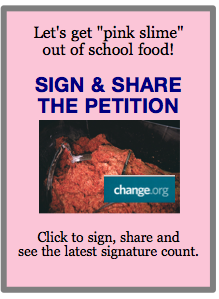I don’t know if you’ve been following the “pink slime” debate, but Bettina Siegel, who is one of the main catalysts behind it, had an op-ed in the Chron that summarized the main arguments.
Last week, the online publication The Daily set off a media firestorm when it reported that the U.S. Department of Agriculture is purchasing ground meat for use in school food which contains, collectively, 7 million pounds of “Boneless Lean Beef Trimmings” (BLBT) – popularly known as “pink slime.”
In the past, slaughterhouse waste – fatty scraps and bits of connective tissue left over from beef processing – was used only for pet food or rendering into cooking oil. People didn’t eat it and, indeed, such waste is banned in Britain for human consumption. But in 2001, a South Dakota company called Beef Products Inc. (BPI) received USDA approval for a new process which extracts fat from the scraps and treats the remaining tissue with ammonium hydroxide to inhibit pathogens such as E. coli and salmonella. The resulting gelatinous pink mass, nicknamed “pink slime” by a horrified government microbiologist, is mixed into ground beef as cheap filler (up to 15 percent in school lunches), reportedly shaving three cents off every pound that contains it.
Meat industry lobbyists maintain that BLBT is nothing more than “lean, nutritious” beef, but two former microbiologists at the USDA’s Food Safety Inspection Service have vociferously protested the agency’s controversial decision to classify BLBT as “meat.” In a 2002 email to colleagues, one of these scientists wrote, “I do not consider the stuff to be ground beef, and I consider allowing it in ground beef to be a form of fraudulent labeling.”
[…]
It’s notable that three leading fast food giants – McDonald’s, Burger King and Taco Bell – all recently discontinued their use of BLBT. Though they haven’t said so explicitly, it’s likely that growing consumer concern over pink slime led to their change in practice. But while fast-food customers can vote with their dollars, our nation’s schoolchildren, particularly those whose lower economic status forces them to rely on federal school meals, lack any voice in the matter.
I recently started a petition on Change.org asking the USDA to reconsider the use of BLBT in meat destined for school meals. In a week and a half, the petition garnered more than 230,000 signatures – and on Thursday, the USDA announced that starting in the fall, schools will be able to opt out of pink slime, choosing between 95 percent lean patties made with the filler, or fattier ground beef made without it, sold in bulk.
This is a good first step. But we need to make sure that schools can actually afford the meat without slime which, because it is sold in bulk, will require labor to form into patties. And we need to insist that pink slime is labeled in grocery-store ground beef. Consumers have a right to know what’s in their burgers.
Seems to me that accurate labeling is a pretty reasonable thing to demand. You can see all of Siegel’s blogging on the subject here, and if you really want to know what difference pink slime makes in terms of taste and edibility, read this intrepid reporter’s taste test. Actually, the taste test is almost an anti-climax. The ordeal he had to go through just to ascertain that he had one sample with pink slime and one without is what’s really eye-opening, and a fine example of Siegel’s point that we deserve to know what we’re eating. The Daily did some legwork on that as well. Check their list and see if you’ve been inadvertently eating this stuff. Then go sign the petition if you agree that you should have known all along.


It’s not entirely clear, but it appears that the taste tester failed to do a blind test. It’s pretty hard to be unbiased when you know which is which.
Eric Berger, Chron.com’s “Sci Guy” (@chronsciguy) tweeted a link to this article from the New Scientist.
The issue of labeling seems to be the main one, agreed. Seems to be totally edible and save. Whether it’s desirable, is something else entirely.